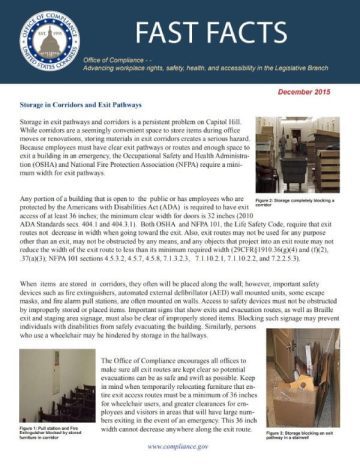Storage in exit pathways and corridors is a persistent problem on Capitol Hill. While corridors are a seemingly convenient space to store items during office moves or renovations, storing materials in exit corridors creates a serious hazard. Because employees must have clear exit pathways or routes and enough space to exit a building in an emergency, the Occupational Safety and Health Administration (OSHA) and National Fire Protection Association (NFPA) require a minimum width for exit pathways.
Any portion of a building that is open to the public or has employees who are protected by the Americans with Disabilities Act (ADA) is required to have exit access of at least 36 inches; the minimum clear width for doors is 32 inches (2010 ADA Standards secs. 404.1 and 404.3.1). Both OSHA and NFPA 101, the Life Safety Code, require that exit routes not decrease in width when going toward the exit. Also, exit routes may not be used for any purpose other than an exit, may not be obstructed by any means, and any objects that project into an exit route may not reduce the width of the exit route to less than its minimum required width (29CFR§1910.36(g)(4) and (f)(2), .37(a)(3); NFPA 101 sections 4.5.3.2, 4.5.7, 4.5.8, 7.1.3.2.3, 7.1.10.2.1, 7.1.10.2.2, and 7.2.2.5.3).
When items are stored in corridors, they often will be placed along the wall; however, important safety devices such as fire extinguishers, automated external defibrillator (AED) wall mounted units, some escape masks, and fire alarm pull stations, are often mounted on walls. Access to safety devices must not be obstructed by improperly stored or placed items. Important signs that show exits and evacuation routes, as well as Braille exit and staging area signage, must also be clear of improperly stored items. Blocking such signage may prevent individuals with disabilities from safely evacuating the building. Similarly, persons who use a wheelchair may be hindered by storage in the hallways.

